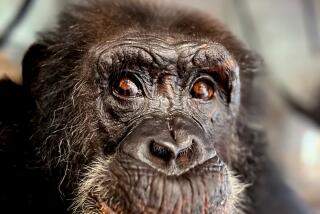L.A. Zoo to retire elephant to animal sanctuary
The Los Angeles Zoo is expected to announce today that it is retiring its female African elephant, Ruby, to an animal sanctuary in Central California.
The decision ends months of speculation over whether the pachyderm would go to another zoo or a sanctuary, and was praised by animal rights activists who lobbied for several years for her retirement to a preserve.
Mayor Antonio Villaraigosa, who has expressed concern about the conditions for elephants at the L.A. Zoo, plans to discuss the decision to relocate Ruby at a news conference today.
“I am very pleased that the city and the zoo recognize that it’s best to send Ruby to a sanctuary, which unlike a zoo can provide the vast space and natural conditions that elephants need,” Catherine Doyle, elephant campaign director for In Defense of Animals, said Sunday night.
Activists have made the zoo’s elephant habitat a rallying cry, long arguing that the giant land animals, which roam miles in the wild and form social bonds, simply do not have enough space at the L.A. Zoo.
State Assemblyman Lloyd Levine (D-Van Nuys), who has tried to mandate space minimums for elephants in captivity, has said that L.A. Zoo elephants simply don’t have enough space to be content. Levine is also expected to appear at today’s news conference at the zoo.
But zookeepers and L.A. Zoo director John Lewis have insisted that space alone is not the issue in caring for captive elephants. Zoo officials had no comment Sunday.
Currently, Ruby is off-exhibit and solitary, having lost the closest thing she had to a companion in the female Asian elephant Gita, who died last summer.
After Gita’s death, Lewis said he would consider either transferring Ruby -- at 46, her breeding years behind her -- to another zoo or sending her to a sanctuary.
The advisory L.A. Zoo Commission voted at a meeting earlier this year to urge that Ruby go to a sanctuary. Ruby’s departure will leave the zoo with only one elephant, Billy, a 22-year-old Asian bull, in residence and on exhibit.
Ruby will go to the Performing Animal Welfare Society’s Ark 2000 elephant sanctuary in San Andreas, southeast of Sacramento.
Like a kind of Leisure World for elephants, PAWS offers some 75 acres of rolling hills to wander, plus a 3-acre lake and mud holes.
“Here, she’ll be able to bathe when she chooses to bathe, mud when she choose to mud, and graze,” said Pat Derby, co-founder and co-director of PAWS.
“We’re really happy the zoo has made this decision,” Derby said Sunday night.
Like any other relocation for an elephant, Derby said, this one will take some adjustment.
“There’s the popular misconception that you put them in the truck, drive to the sanctuary, let them out and they all live happily ever after,” said Derby, who has been caring for elephants at a sanctuary for 21 years.
“Every move is traumatic and stressful for an elephant. They’re grounded in routine. They don’t adapt well to a change. It will be a real experience for her.... I will say she’s healthy and she doesn’t have any major medical problems, and she has a really lovely personality. I feel she will move more quickly.”
The L.A. Zoo joins a small but significant list of institutions that have decided, for the good of the animals, to retire elephants.
Eight zoos accredited by the Assn. of Zoos and Aquariums -- including San Francisco and Detroit -- have placed a total of 11 elephants in sanctuaries, Doyle said.
The L.A. Zoo, however, is in the interesting position of retiring one elephant to a sanctuary but not getting out of the elephant-keeping business. In fact, the zoo has embarked on an ambitious, $39-million capital project to build a new pachyderm habitat that is expected to be devoted to keeping and breeding Asian elephants.
Ruby came to the L.A. Zoo from Circus Vargas in 1987, but was sent off to Tennessee’s Knoxville Zoo in 2003 to serve as a maternal example to other elephants. In her wake, she left outraged animal rights activists who said the zoo was breaking the bond between Ruby and Gita, and even filed a lawsuit to get her returned. She did come back to L.A. in 2004 after her introduction to the herd in Knoxville proved unsuccessful. But she has been off-exhibit ever since, a result of construction on the zoo grounds.
The zookeepers and the director have always staunchly defended their management of and devotion to the elephants. Principal elephant keeper Jeff Briscoe has spent years caring for the zoo’s elephants and travels to see them in the wild.
Animals in captivity are well-cared for, Briscoe said, and not subject to “incredible humanelephant conflict issues” that plague pachyderms in the wild, Briscoe said last year.
“There are space issues and poaching. It’s important to keep them in people’s eyes so they pay attention.... These guys are safer here than out there.”
*
More to Read
Sign up for Essential California
The most important California stories and recommendations in your inbox every morning.
You may occasionally receive promotional content from the Los Angeles Times.











